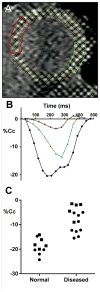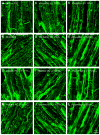T-tubule disease: Relationship between t-tubule organization and regional contractile performance in human dilated cardiomyopathy
- PMID: 25953258
- PMCID: PMC4467993
- DOI: 10.1016/j.yjmcc.2015.04.022
T-tubule disease: Relationship between t-tubule organization and regional contractile performance in human dilated cardiomyopathy
Abstract
Evidence from animal models suggest that t-tubule changes may play an important role in the contractile deficit associated with heart failure. However samples are usually taken at random with no regard as to regional variability present in failing hearts which leads to uncertainty in the relationship between contractile performance and possible t-tubule derangement. Regional contraction in human hearts was measured by tagged cine MRI and model fitting. At transplant, failing hearts were biopsy sampled in identified regions and immunocytochemistry was used to label t-tubules and sarcomeric z-lines. Computer image analysis was used to assess 5 different unbiased measures of t-tubule structure/organization. In regions of failing hearts that showed good contractile performance, t-tubule organization was similar to that seen in normal hearts, with worsening structure correlating with the loss of regional contractile performance. Statistical analysis showed that t-tubule direction was most highly correlated with local contractile performance, followed by the amplitude of the sarcomeric peak in the Fourier transform of the t-tubule image. Other area based measures were less well correlated. We conclude that regional contractile performance in failing human hearts is strongly correlated with the local t-tubule organization. Cluster tree analysis with a functional definition of failing contraction strength allowed a pathological definition of 't-tubule disease'. The regional variability in contractile performance and cellular structure is a confounding issue for analysis of samples taken from failing human hearts, although this may be overcome with regional analysis by using tagged cMRI and biopsy mapping.
Keywords: Contraction; Heart failure; Human; t-tubules.
Copyright © 2015 Elsevier Ltd. All rights reserved.
Figures






Comment in
-
Measuring the metrics: Correlating t-tubule structure and muscle contraction in the intact heart.J Mol Cell Cardiol. 2015 Aug;85:153-4. doi: 10.1016/j.yjmcc.2015.05.015. Epub 2015 May 29. J Mol Cell Cardiol. 2015. PMID: 26031703 No abstract available.
References
-
- Cheng H, Cannell MB, Lederer WJ. Propagation of excitation-contraction coupling into ventricular myocytes. Pflugers Arch. 1994 Oct;428(3–4):415–7. - PubMed
-
- Brette F, Despa S, Bers DM, Orchard CH. Spatiotemporal characteristics of SR Ca(2+) uptake and release in detubulated rat ventricular myocytes. J Mol Cell Cardiol. 2005 Nov;39(5):804–12. - PubMed
Publication types
MeSH terms
Substances
Grants and funding
LinkOut - more resources
Full Text Sources
Other Literature Sources

